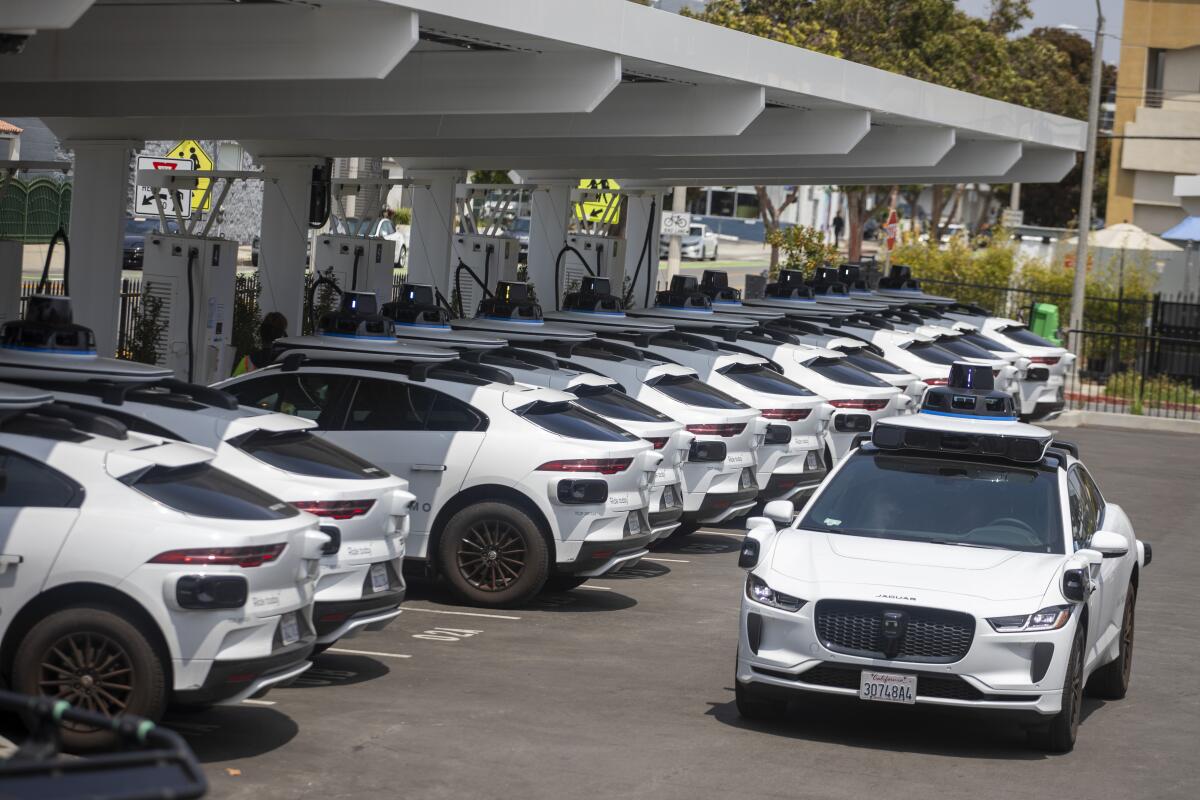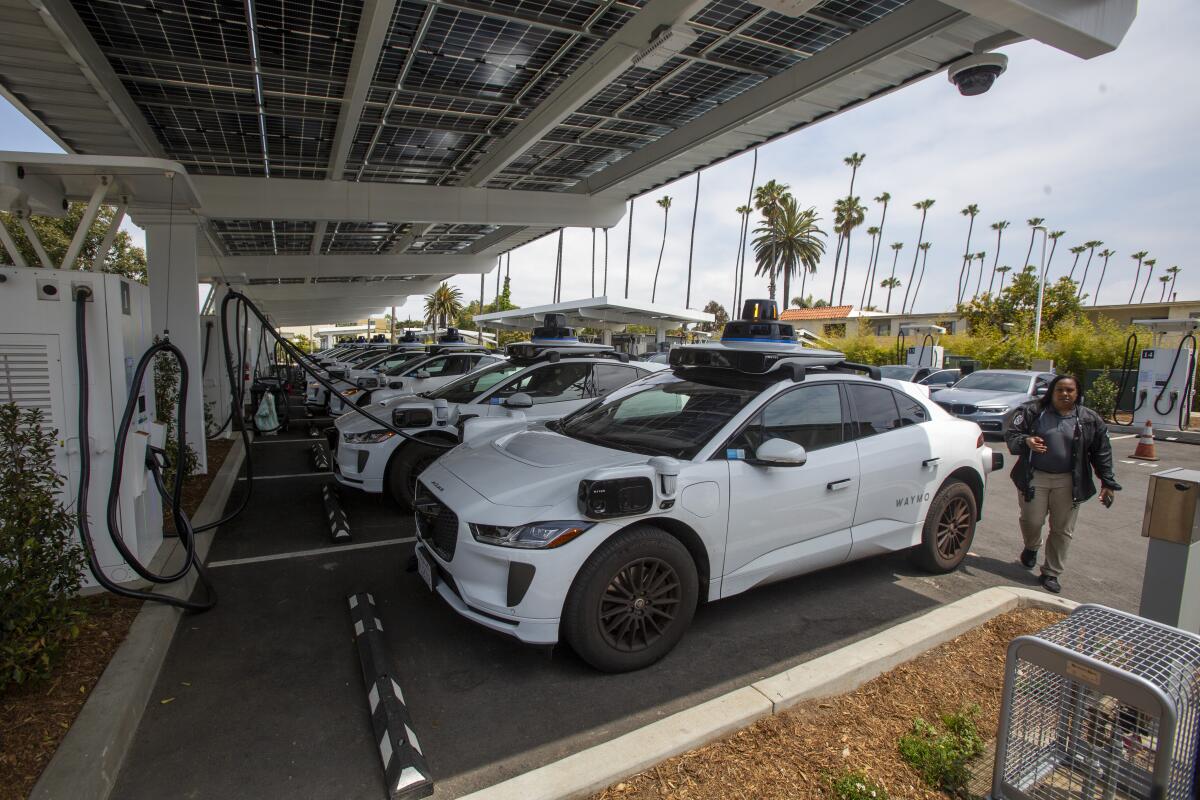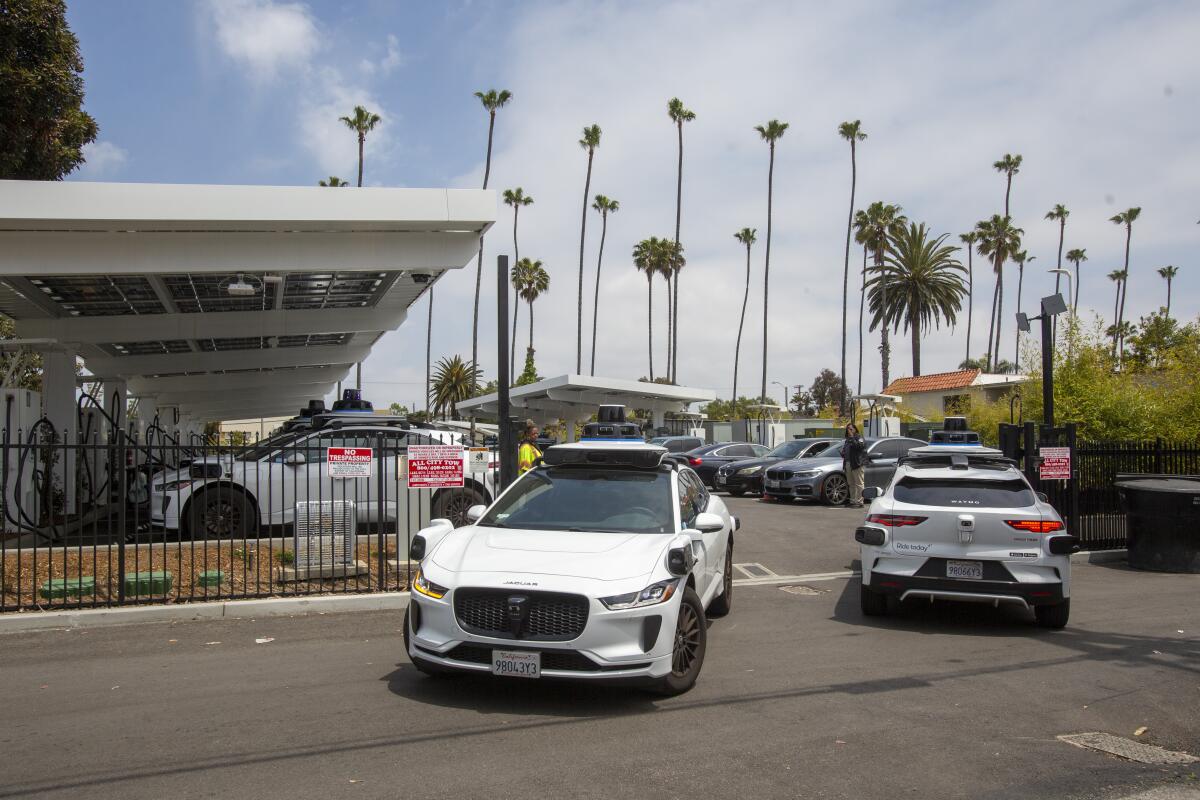Santa Monica residents go to war against Waymo, including obstructing driverless taxis

- Share via
There’s a battle brewing in Santa Monica with a fleet of unmanned, electric Waymo vehicles on one side, and exhausted, weary locals on the other.
City officials, a judge and even police have been forced to intercede after residents who say the self-driving cars are a nuisance have banded together against the local 56-vehicle fleet. They’ve reached out to the city. They’ve called Waymo. Now, some are trying unconventional tactics.
Using cones, cars and sometimes themselves, residents have taken to blocking the Waymos from entering their company-funded parking lot, so much so that the company has called the cops on them half a dozen times.

“I want the noise stopped,” said Darius Boorn, who lives next to one of the lots and has a front-row seat to the antics. “I thought it was cool, and then those freaking noises started. And then I thought, ‘Oh no, this can’t be happening.’ ”
For city officials, the clashes have come as a surprise. They had no idea Waymo had set up charging stations in their backyard. According to emails obtained by The Times, the city learned about the Waymo lots only after complaints from residents started coming in.
In light of the revelation, a Waymo spokesperson said the company “will continue to learn and improve how we introduce ourselves to new communities when we arrive.”
But for many, the company has already worn out its welcome.
“This was not what we signed up for,” said Christopher Potter, a 51-year-old Santa Monica resident who lives near one of the lots.
In January, after months of the self-driving taxis operating on the beach city’s roads, Waymo opened two charging stations for more than 50 vehicles, establishing Santa Monica as a base for operations. The white, electric cars with rotating sensors on their roofs first drew curious looks as they drove themselves in to recharge, beeping as they reversed, maneuvering into their slots.
But to hear it from residents, the beeping never seems to stop, largely due to a state regulation requiring electric vehicles to audibly reverse like delivery trucks. They beep as they back out of charging spots, and beep as they reverse to navigate around one another. They beep in the morning as they head out to pick up early passengers, and beep late at night as they return to charge up.
The noise eventually reverberated through City Hall, causing staff to look into the issue.

“What particularly surprised and concerned us is that this site had never come up as a Waymo hub or parking/charging location on any of our previous check-in calls — yet there is clearly a substantial Waymo operation occurring out of these lots that is drawing concern,” Anuj Gupta, Santa Monica’s director of transit services, wrote to Waymo’s city policy and government affairs manager in a Feb. 11 email.
The company apologized and promised to address noise concerns. However, residents say the racket persists. City staff recently checked the sound levels emanating from the lots and confirmed that they were within city noise limits, leaving officials little recourse.
Undeterred, residents are filling the void with their own measures.
Orange cones are mysteriously appearing on roads and alleyways leading to the lots, forcing the driverless cars to stop. Sometimes, with no apparent rhyme or reason, a vehicle will be stopped in front of a lot entrance, blocking the Waymo’s path.
In other instances, it will be a slow-walking resident who just happens to be in the way, triggering a backup of the cars in a strategy that locals have taken to calling “stacking the Waymos.”
One resident was so effective at disrupting operations that parking lot workers called the police on him six times and the company unsuccessfully sought a temporary restraining order from a judge.
Initially created as a test project for self-driving cars at Google in 2009, Waymo was launched in 2015 as its own company and has rapidly increased its presence across major cities. According to the company, it has a presence in San Francisco, Los Angeles, Phoenix and Austin, Texas. Its current fleet of 1,500 vehicles makes more than 250,000 paid trips a week, and the company has already announced plans to expand.

Its arrival in Santa Monica appears to have flown under the radar because it subleased the lot from another company and capitalized on its existing charging infrastructure.
“They were not obligated to tell us, since they’re renting it from a third party,” said Lauren Howland, a city spokesperson. “That said, they’ve been good partners overall, keeping us well informed on various matters and ... have engaged with us to mitigate the impacts of this site on the neighbors.”
The lots were initially permitted as private charging stations for a fleet of autonomous ride-hail vehicles in June 2024 to Palo Alto-based Voltera, according to emails and documents obtained by The Times. That company then leased it to Waymo, which began operating out of the lots off on the intersection of Euclid St. and Broadway in January.
Representatives from Voltera did not respond for a request for comment. But a post on LinkedIn in January shows Voltera celebrating its new partnership with the company.
Representatives from Waymo and the city say they have been collaborating to try to minimize the noise as the complaints have piled up.
“We strive to be good neighbors in the cities that we operate and are committed to being a positive presence in Santa Monica,” a Waymo spokesperson said.
Among some of the changes the company has made, the spokesperson said, are limiting hours that staff members work at the lots, purchasing quieter vacuums to clean the cars, and installing fast-growing bamboo stands to try to absorb some of the noise.
So far the efforts have left some residents unimpressed.
“C’mon, it’s lipstick on a pig, baby,” Boorn said.
Caroline Torosis, mayor pro tem of Santa Monica, said that Waymo has taken steps such as limiting cleaning operations at night, but that the beeping has been difficult to address because of state and federal regulations.
“The issue here is that they are sounds that the vehicles are required to make,” Torosis said. “I’m totally sympathetic to the quiet enjoyment of property, so we’re trying to get this under control.”

The noise of Waymos moving in and out of the lot has been so constant over the last four months, Boorn said, he’s hearing phantom beeps. At times, he’s gone to his father’s home just to avoid the sound.
“I’ll just stand still for a second, because I think I hear it,” he said. “If we’re home all day and night, then we’re hearing the beeping 24 hours a day.”
Potter, meanwhile, started an online petition, urging the Google-owned company to reduce sound pollution in the lots. The petition has 140 signatures and has been up for two months.
Backlash to Waymo parking lots isn’t unheard of.
In San Francisco, the city sued the California Public Utilities Commission when Waymo increased its presence there. San Francisco officials argued the agency had unlawfully allowed Waymo to expand operations, saying the commission had ignored safety concerns over the self-driving cars. A state court rejected the city’s lawsuit in January.
In Santa Monica, the city has gone beyond just working with the company to find solutions; city leaders are looking to reach out to state regulators, exploring whether there is a way to reduce the volume of the backup beeping the vehicles are required to make.
“We need to make sure that as we have some of these new business practices coming into the city, while not stifling innovation, that we’re putting the needs of our residents here in front,” Torosis said.
In the meantime, some locals say they’ll continue to deal with the Waymos themselves. On a recent evening, a resident told a Times reporter, the honking Waymos woke them up after midnight, again. So the resident got up, headed out and once again started stacking the Waymos.
More to Read
Sign up for Essential California
The most important California stories and recommendations in your inbox every morning.
You may occasionally receive promotional content from the Los Angeles Times.














